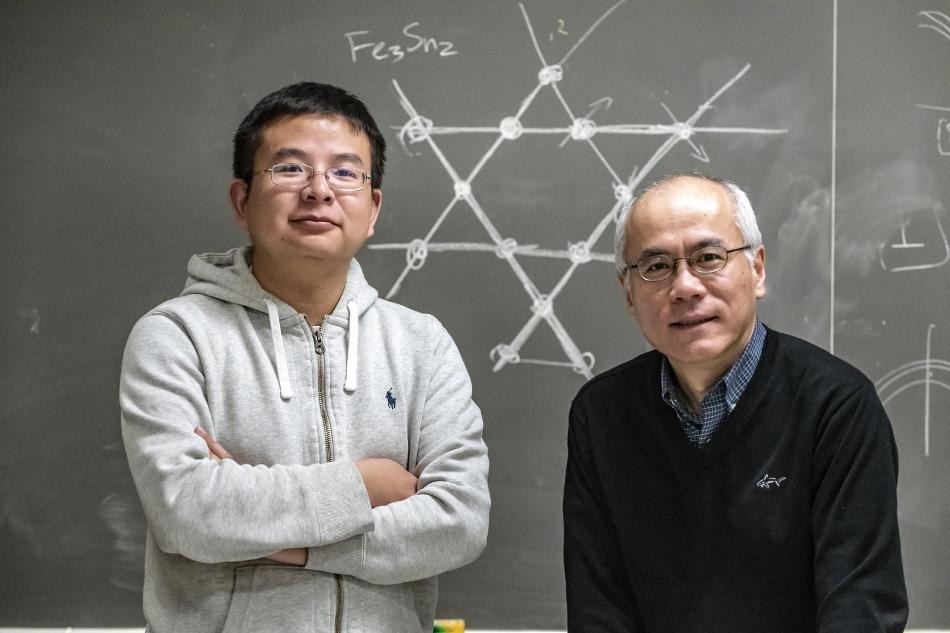Dec 10 2018
Similar to various targets of scientific inquiry, kagome magnet, a unique class of material, has turned out to be a source of both amazement and frustration. Unraveling the quantum properties of the kagome magnet, even more, is considered to be one of the main challenges in fundamental physics—to theorists as well as experimentalists.
 Boston College researcher Kun Jiang, PhD, and Professor of Physics Ziqiang Wang. The theoretical physicists have been studying novel quantum electronic states resulting from the interplay of electron-electron interaction, geometrical frustration, and topological band structures. (Image credit: Lee Pellegrini/Boston College)
Boston College researcher Kun Jiang, PhD, and Professor of Physics Ziqiang Wang. The theoretical physicists have been studying novel quantum electronic states resulting from the interplay of electron-electron interaction, geometrical frustration, and topological band structures. (Image credit: Lee Pellegrini/Boston College)
These materials get their value from a strange fundamental geometry of the atomic arrangement. Kagome lattices are depicted as intersecting webs of “corner-sharing triangles” and are treasured for the distinctive behavior of the traversing electrons, a prolific zone for the investigation of quantum electronic states described as correlated, frustrated, and topological.
A recent research by an international team of researchers, reported in the Nature journal, describes that the kagome ferromagnet Fe3Sn2 has an electronic state that, strangely, couples strongly to an applied magnetic field that can be rotated to point in any direction of a three-dimensional space, unraveling in quantum scale a “giant” magnetization-driven electronic energy shift that occurs inside the material.
This energy shift offers new insights into the existence of topological spin textures and spin-orbit coupling in kagome lattices, where electronic and magnetic structures are entangled and give rise to strange—often previously obscure—spin-orbit activity, stated Boston College Professor of Physics Ziqiang Wang, a co-author of the report, titled “Giant and anisotropic spin-orbit tunability in a strongly correlated kagome magnet.”
We found out two things. The first one is that the electronic state of Fe3Sn2 is nematic, a state that spontaneously breaks the rotation symmetry. The electrons behave as a liquid crystal inside this magnet, presumably due to the strong electron-electron interaction. The second thing we found is you can manipulate and make big changes to the electron energy structure through tuning the magnetic structure by applying a magnetic field.
Ziqiang Wang, Professor of Physics, Boston College.
Wang, who is a theoretical physicist, and graduate student Kun Jiang, PhD, who have been investigating unique quantum electronic states arising from the interplay of geometrical frustration, electron-electron interaction, and topological band structures, joined experimentalist collaborators who were the first to observe the strange electronic activity when they investigated the material with the help of scanning tunneling microscopy.
The group—including scientists from Boston College, Princeton University, Chinese Academy of Sciences, Renmin University, and Peking University—applied STM and vector-magnetic-field tools to recognize the spin-orbit coupled electronic properties of the kagome ferromagnet and investigated the exotic phenomena integrated in it, while carrying out modeling and calculations to offer theoretical interpretation and insights into the noted phenomena.
What our colleagues found is that by changing the direction of the magnetic field, they saw changes in the electronic states that are anomalously large. The shifts of the bands—there are band gaps, forbidden regions in quantum mechanics where electrons cannot reside—those regions can be tuned enormously by the applied magnetic field.
Ziqiang Wang, Professor of Physics, Boston College.
According to Wang, the “band shift” is a variation in electronic band structure. It enlarges and contracts the band gap based on the magnetic field directions. The kagome ferromagnet exhibited a shift roughly 150 times larger compared to ordinary materials.
When the interference patterns of the quantum mechanical wave functions of the electron were analyzed, consistent spontaneous nematicity was revealed, indicating the presence of significant electron correlation that results in the rotation symmetry-breaking of the electronic state in the material.
These spin-driven giant electronic responses pointed toward the probability of an underlying correlated magnetic topological phase, the scientists reported. The fact that the kagome magnet is tunable indicated a strong interplay between an externally applied magnetic field and nematicity, offering innovative ways of controlling spin-orbit characteristics and analyzing emergent phenomena in quantum or topological materials.
The huge magnetic field tunability of the electrical characteristics may someday result in prospective applications in electronic devices like memory and information storage and sensing technologies, stated Wang.
What’s exciting in these results is the potential of realizing something useful. This is coming from very fundamental physics, but it may one day connect to applications. We don’t understand everything, but we now know this is a material that contains all these important ingredients.
Ziqiang Wang, Professor of Physics, Boston College.